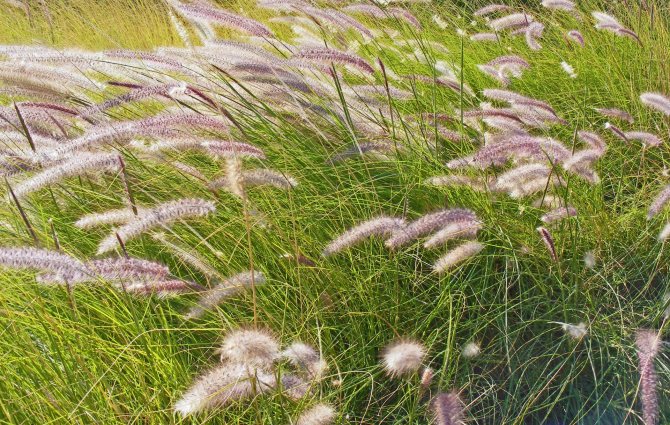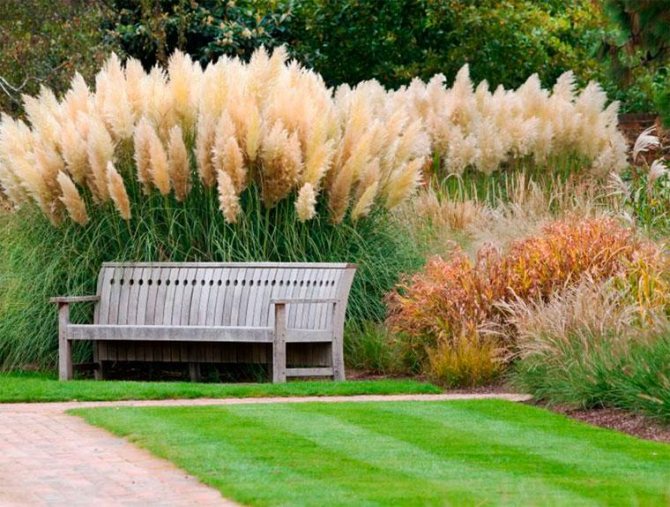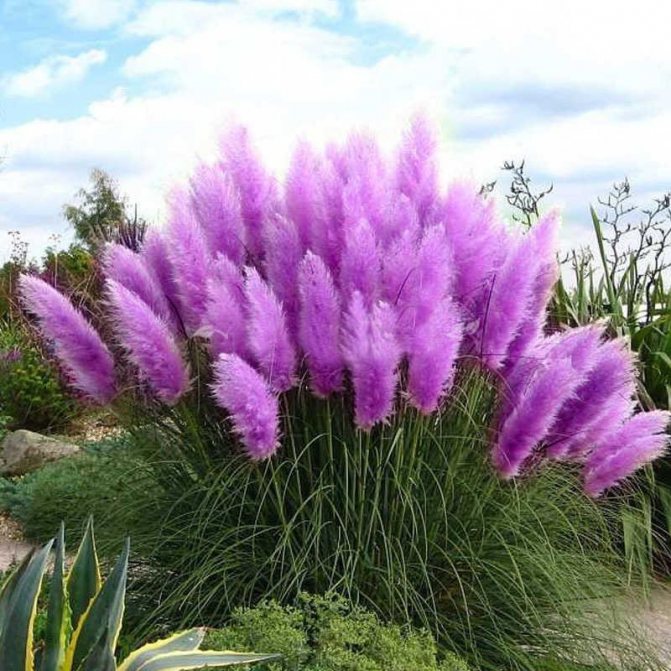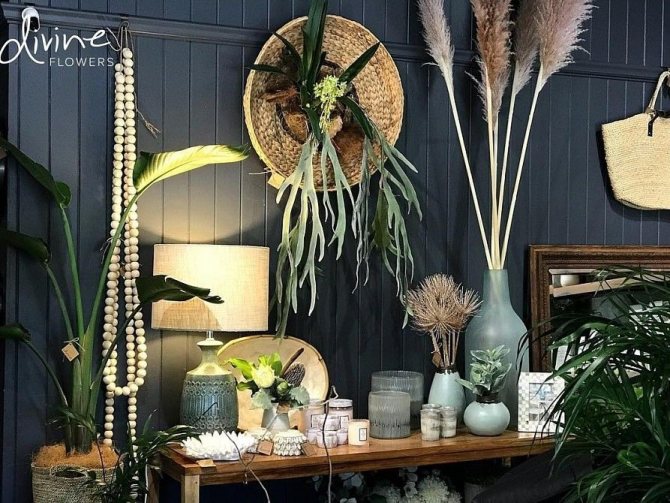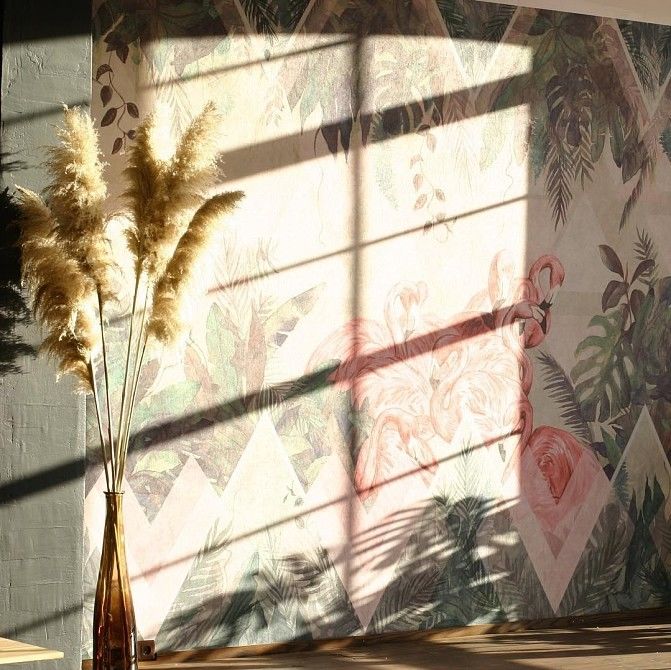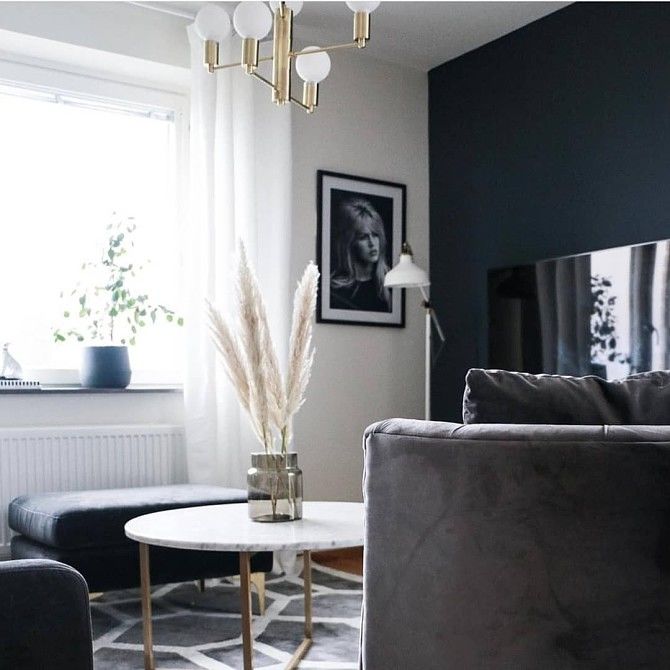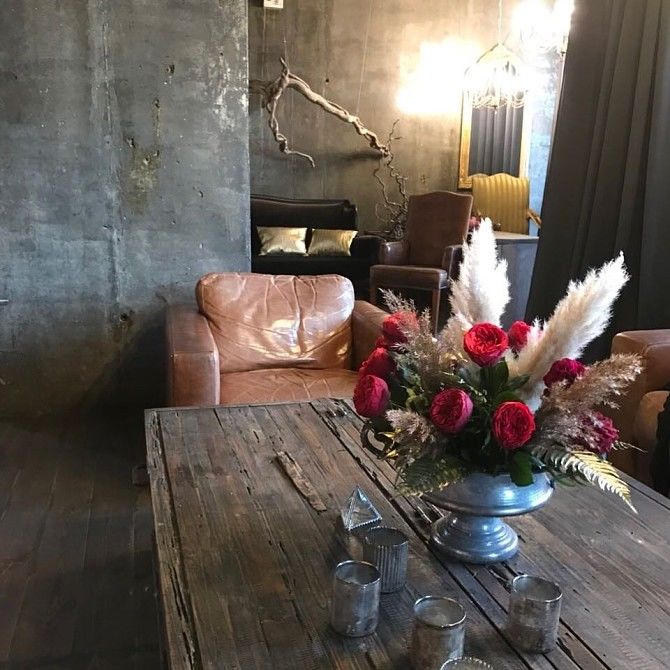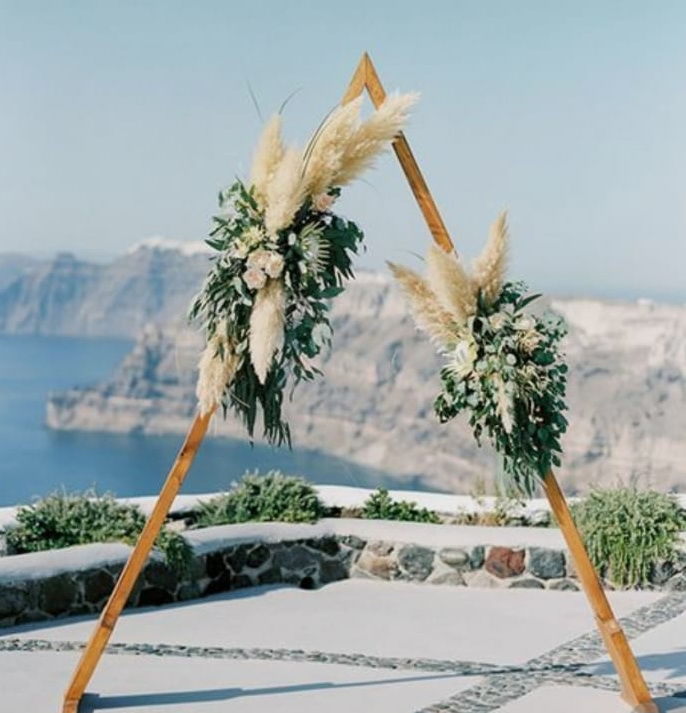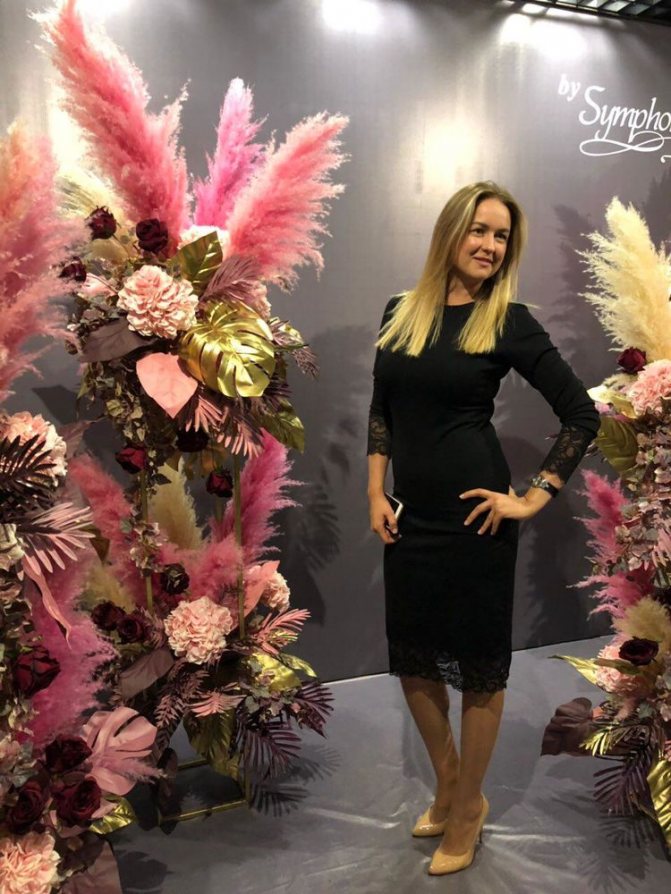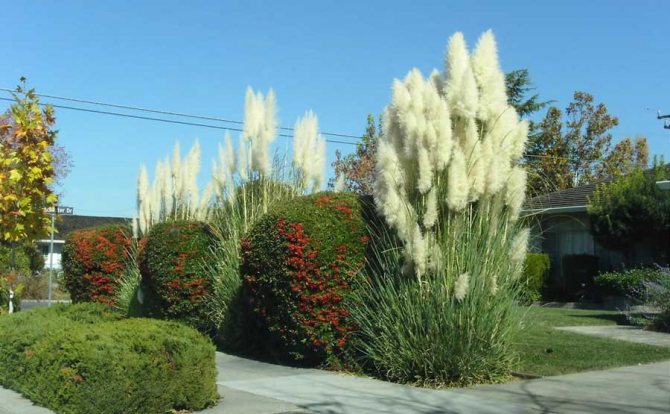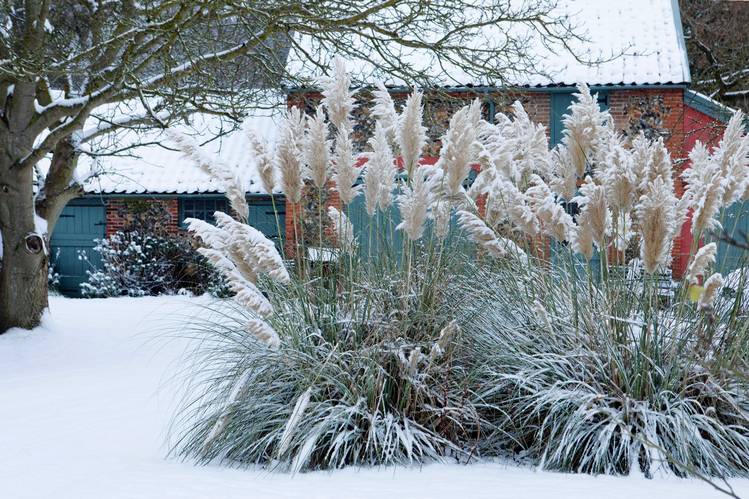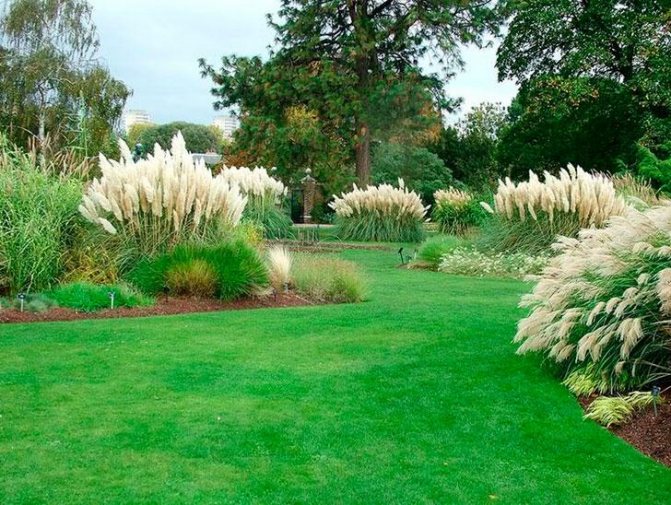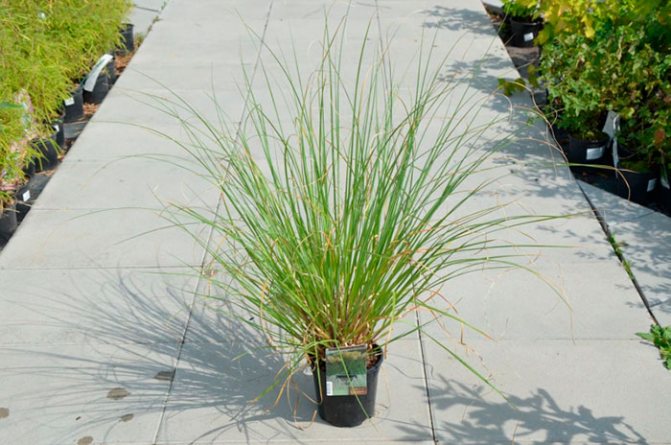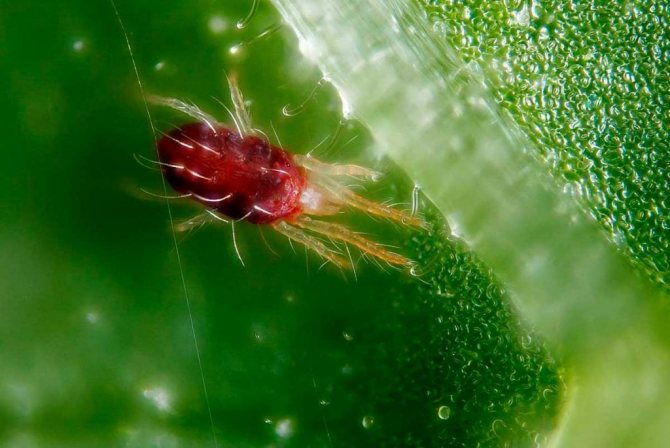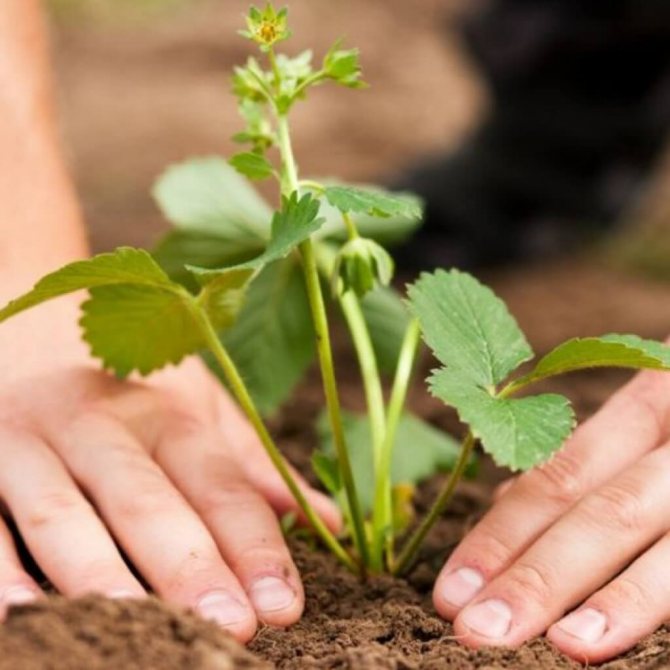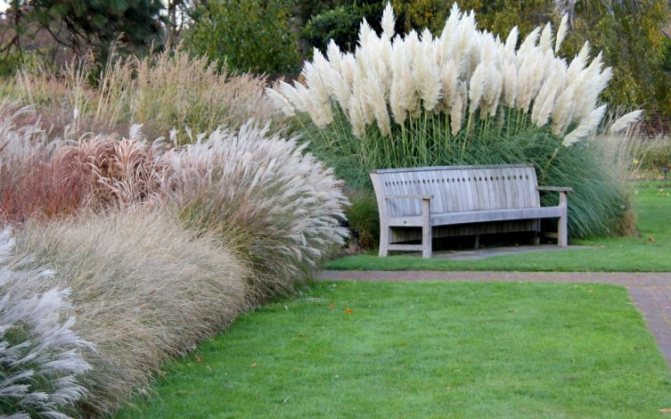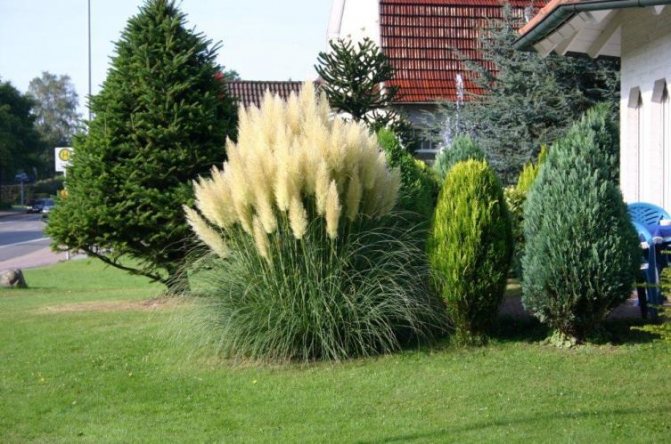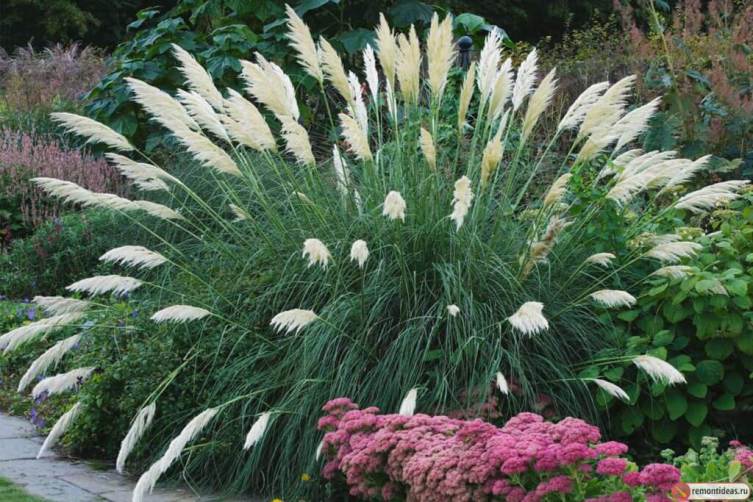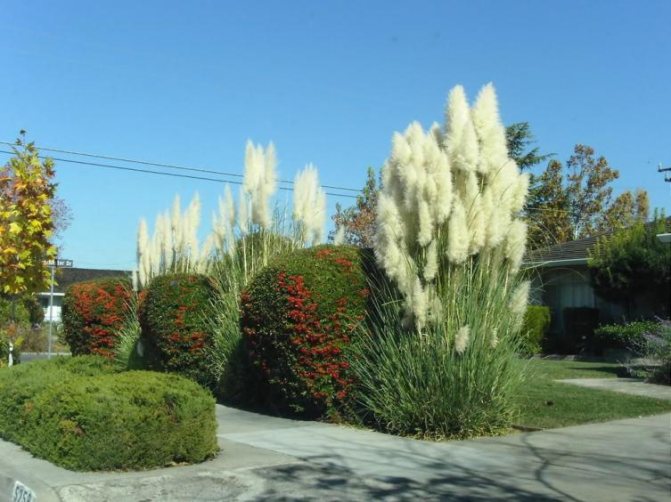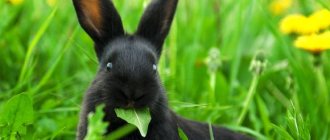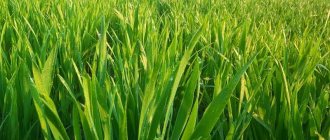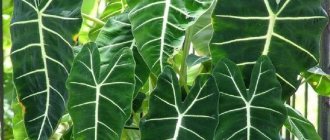Hello my readers! If you do not know what plant to decorate your front garden with, do not despair. A versatile and original solution would be a pampas grass planting and caring for this grass crop is not as difficult as it might seem at first glance.
Moreover, this ornamental grass does not belong to the capricious varieties of plants. Absolutely any soil is suitable for its cultivation, and any novice gardener can do this process.
Botanical description
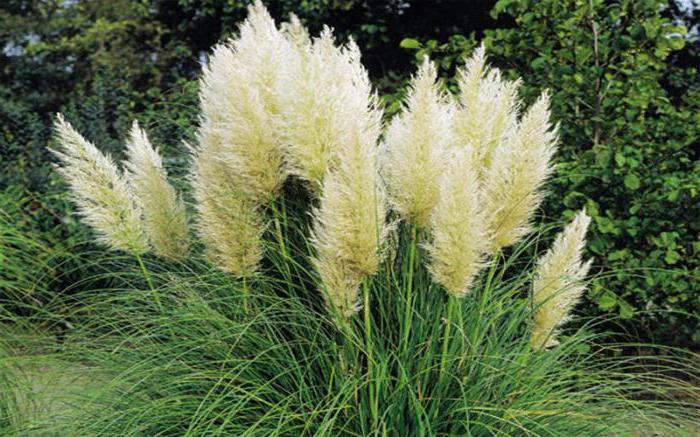
Cortaderia, or pampas grass, is a common cereal of the same genus in South America. A large herbaceous plant is a perennial and grows up to 3 m in height, while forming dense bumps (turf). For decorative floriculture, its long (1-2 m) and thin leaves about 1 centimeter wide with a bluish or silver-gray tint, as well as original panicle inflorescences, are of interest. The latter, like arrows, jump out of the turf on a long two- or three-meter peduncle. Panicles are loose, up to 30-40 cm in size, with flowers painted exclusively white or with a silvery sheen, less often yellow or pink-purple, reddish. The flowering period occurs in late summer and autumn (August - November).
Cortaderia varieties with photos and names
The genus has 25 species, but only one is cultivated (Cortaderia Sello) with several varieties.
Popular varieties:
Cortaderia Sello Pink Pampas Grass Pink Pink Pampas Grass - Cortaderia selloana Rosea
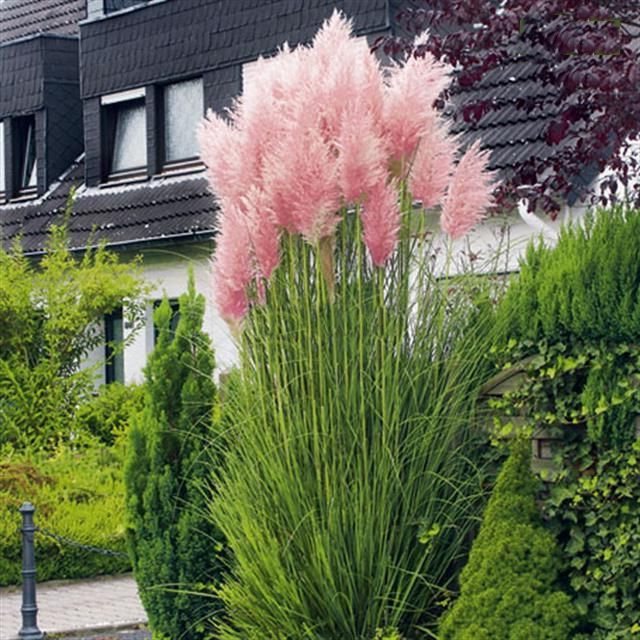

Cortaderia selloana Rosea
Rosea (Pink) - reaches a height of 2 m. Panicles have silvery-pink inflorescences.
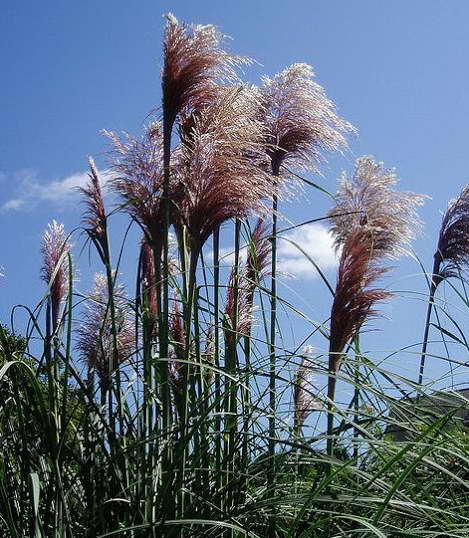

Cortaderia pink color smoky pink variety Rendatleri photo
Interesting variety Rendatleri with ash-pink inflorescences.


Cortaderia sello pink pink variety Cortaderia selloana Pink Feather photo
Pink Feather - bushes about 2 m high with pinkish inflorescences, green-gray leaves.
Cortaderia Silver
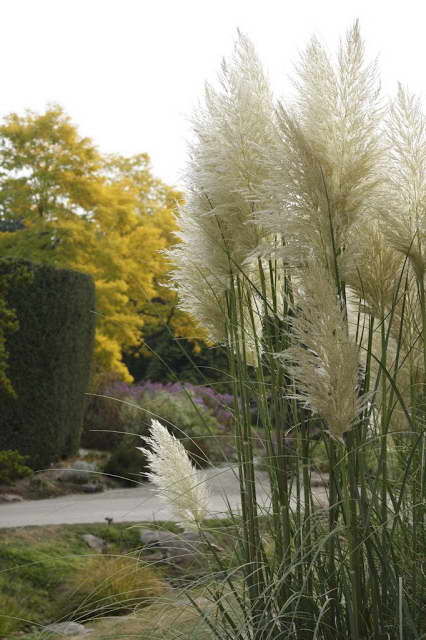

Cortaderia Sunningdale Silver photo
Sunningdale Silver - inflorescences have a silvery shade.


Cortaderia silver Silver Stripe photo
Silver Stripe is a two-meter bush with white-silvery inflorescences, variegated leaves: there are silvery-white stripes along the edges.
Cortaderia Gold Gold Band Gold Band
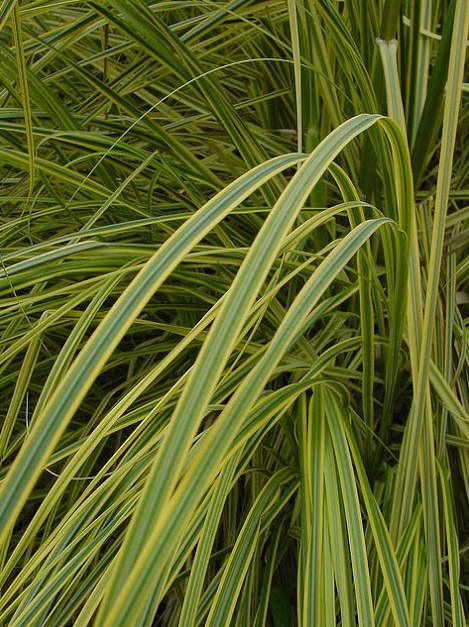

Cortaderia Gold Band photo
Gold Band is also a variegated variety, with leaves along the edge of a green-golden hue.
Cortaderia beige
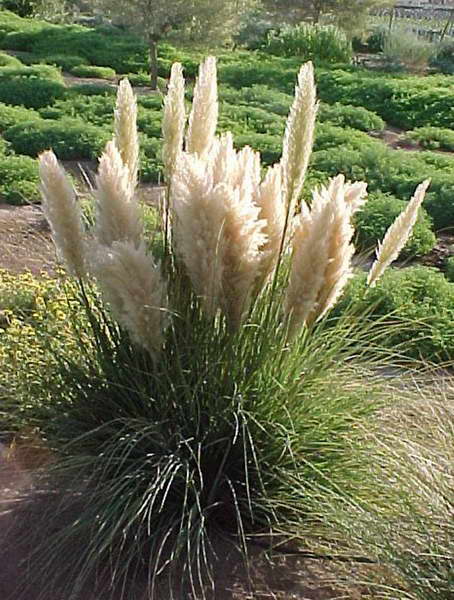

Cortaderia beige Pumila photo
Pumila - height is about 1.5 m. Inflorescences are yellow-silvery.
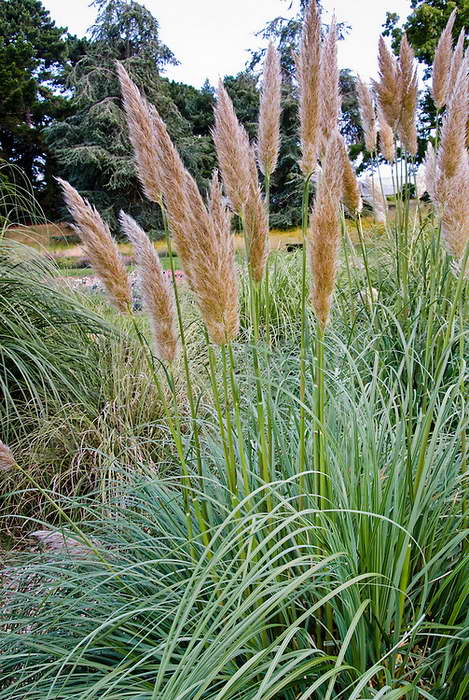

Courtyardia Sello Patagonia Patagonia photo
Patagonia - reaches a height of 2 m, the inflorescences are beige-silvery, the leaves are gray-green.
Cortaderia white


Courtyardia white Splendid Star photo in the garden
Splendid Star - the height of the bush is limited to 1.5 m. The panicles are milky white, the leaves have a golden green hue.
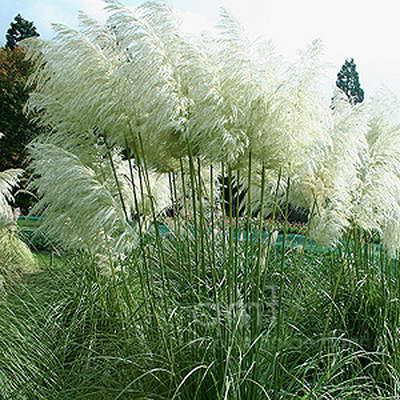

Cortaderia sello white cultivar Cortaderia selloana - ‘Monstrosa’ photo
Monstrosa - the height is 2 m, the leaves have a bluish tint, the inflorescences are white, with long drooping silky strands.
Pampas grass: planting seedlings
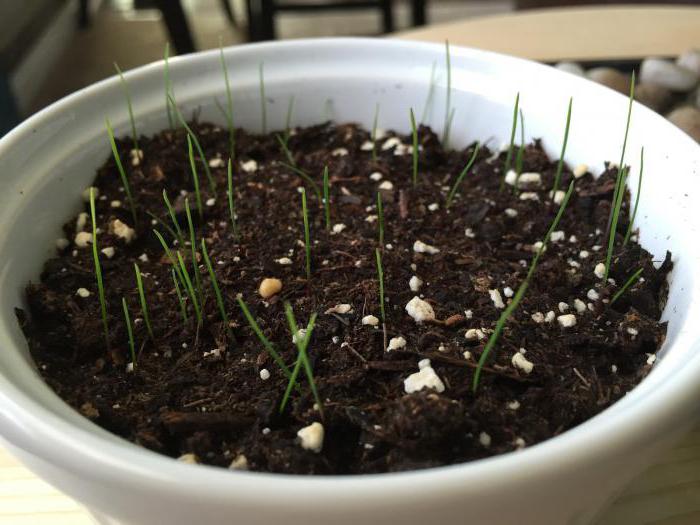

This plant has a luxurious appearance and at the same time an absolutely unpretentious character. Kortaderia has shown itself well in the Moscow region and in general in central Russia, where in a couple of years it forms large bushes. At the same time, minimal maintenance is required, and sowing is carried out directly into the ground in the fall.However, the prevailing territory of our country is located in zones with a more severe climate. Therefore, planting seeds in autumn is unacceptable. The process must be carried out in the spring and best of all by the seedling method.
Pampas grass, as already mentioned, is unpretentious, so you can use any universal soil. Plant seeds require preliminary stratification, that is, holding at low temperatures for 1.5-2 months. This will significantly speed up and improve the germination process. Place the seeds directly in the bag in the refrigerator in early to mid-January. After waiting 1.5-2 months, you can safely sow them for seedlings.
In a previously prepared shallow container, moisten the earth with a spray bottle and carefully sow the seeds, sprinkle them with soil only slightly on top (3-4 mm). Wrap the container in a transparent bag and place in a warm place. Long thin green threads that appear after 1-2 weeks and resemble the familiar bluegrass to all of us - this is the pampas grass. Planting seeds for seedlings will allow you to plant an already formed young plant in the ground, which, although it will not bloom in the first 3-4 years, will still be strong and will more easily endure any weather conditions.
Seedling care
No special care of the seedlings is required. Timely watering will be enough. Place the container with seedlings in a sunny place. When several real leaves appear, you can plant each seedling in a separate glass. Note that pampas grass has a very strong and powerful root system. It is she who provides its high resistance to drought. Seedlings can easily be transplanted and, having received a separate "place of residence", begin to develop even better and faster.
Briefly about culture
Cortaderia got its scientific name from the Spanish verb meaning “to cut”. This happened because the edges of the leaves of the plant are very sharp. If you touch them carelessly, you can get hurt. Cortaderia is one common name for 23 species of perennials related to cereals or, as they are also called, bluegrass. Some members of this family are called "pampas grass".
Their characteristic features are:
- the ability to form sod on the soil surface;
- panicle-like inflorescences that appear at the end of the summer period and delight the eye all winter;
- powerful root system that goes deep into the ground;
- high seed productivity, which makes the fight against the representative of cereals difficult.
Note! Before the seeds are ripe, the pampas grass is poisonous. During the ripening period, it becomes safe for human life and health.
Landing in the ground: choosing a place and soil


Planting the cortaderia into the ground is possible only after the cold weather has passed and the threat of frost has passed. At the same time, you can divide the mother bushes for the purpose of reproduction. For planting pampas grass, choose a permanent place immediately, since the subsequent transplant will be very difficult. The plant is undemanding to the ground and can develop both on stony soil and on swampy or very dry soil. However, he needs a lot of sun and light. Therefore, give preference to well-ventilated open areas.
Pampas grass: care
No special care of the cortaderia is required. Water young plants in the first year of their life regularly once every two weeks, in case of drought - more often. Adult specimens take root so deep that they can replenish moisture from groundwater. Top dressing with complex mineral fertilizers should be carried out once in early spring, when the plant starts to grow. In autumn or spring, the bushes are cut to a level of 30-40 cm.
Another advantage of the pampas grass is its absolute resistance to fungal and bacterial diseases, as well as various garden pests, therefore, no special treatment is required.
Diseases and pests
Ornamental grass has strong immunity and endurance. The ornamental plant does not have problems with garden pests due to its hard leaves, therefore, preventive treatments are not required.
Ornamental grass has strong immunity and endurance.
In rare cases, the plant can be infected with anthracnose or powdery mildew. Then the affected parts are removed and sprayed with a fungicide. In dry and hot summers, aphids or spider mites can attack the Pampas grass. Sick individuals are treated with insecticides.
Wintering pampas grass
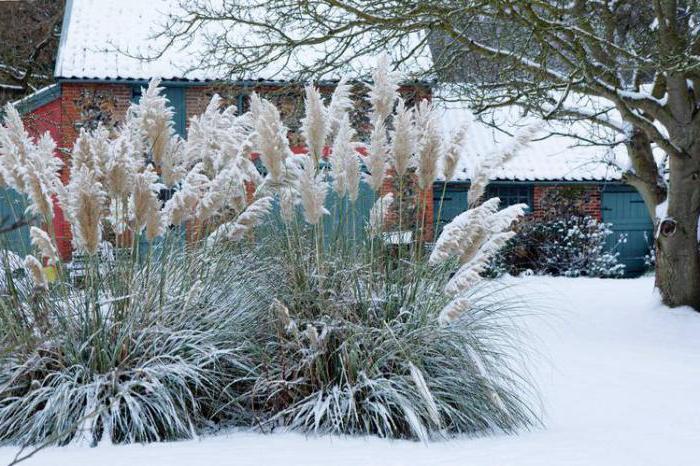

One of the most common questions asked by gardeners: "Does the cortaderia hibernate in the open field?" The answer to it, in fact, depends on which zone the plant is grown in. As mentioned above, in the conditions of the Moscow region and the middle lane, the grass develops well and tolerates wintering. But what about those who want to grow a cortaderia in the Urals or Siberia? It is important to choose the right variety, place and, of course, not neglect the shelter for the winter. In addition, there is a very common method of growing pampas grass - container. In spacious containers, the plants winter safely in a warm room, and in the summer they move to the garden.
To prepare the plant for winter, in October-November, the leaves of the grass are cut and tied in a large bunch. Further, it is recommended to fence the space around the bush with a net and fill it with straw, hay or other mulch, and additionally insulate the roots with a special material on top. The issue of growing pampas grass is largely individual, besides, the plant adapts well to growing conditions. However, you need to be prepared for the fact that decorativeness and size suffer.
Use in garden design


In garden design, pampas grass plays the role of an architectural plant and is used to create vertical accents. It is recommended to plant it with a tapeworm in an open space, it looks especially impressive against the background of a smooth emerald lawn. Or use a plant in the background of a mixed flower garden. Cortaderia is irreplaceable in the design of reservoirs. The combination of its needle-like bluish-green leaves with stones looks especially beautiful.
Pampas grass is a plant that requires a lot of space, only in this way its beauty is fully revealed. If your garden is small, then it may be worth refraining from planting it and preferring more miniature grains. In addition, you should not plant it close to garden paths, playgrounds, since the partially lodging long leaves of the grass can get tangled, moreover, they are quite sharp and easily damage the skin.
Queen of herbs
Cortaderia selloana of the family of cereals is considered one of the most beautiful ornamental garden plants with characteristic, usually white or cream-colored inflorescences - panicles. The most original inflorescences are pink varieties. Cortaderia inflorescences can be up to 1 meter long and are sometimes called fox's tail.
The perennial owes its popular name to its natural habitat. The term "pampas" comes from the pampas, or steppe grassy steppes in South America, where cattle graze, typical of some regions of Argentina, Brazil, Chile. The soil there is fertile, permeable, rich in calcium. Bushes reach a height of 2.5-3 meters, grow widely.
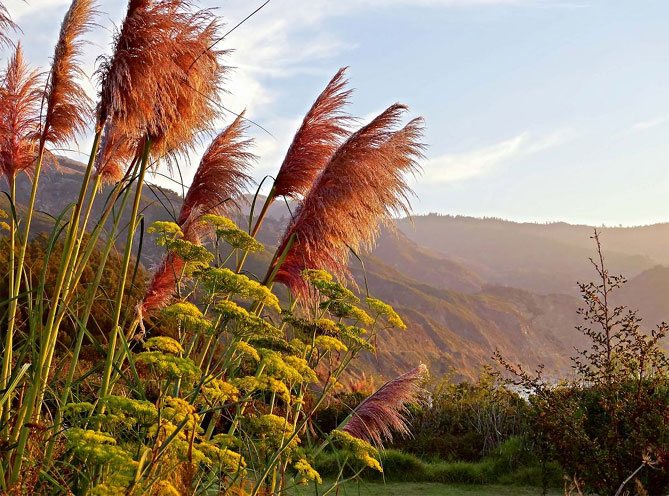

The great advantage of the plant is that from spring to August it acts as an excellent background element. Leaves can fill a square meter of surface, are compact, usually have a pure blue-green color. The plant then gives flowers and plays the role of a soloist in the garden.
Cortaderia blooms at the turn of September and October, large inflorescences adorn the bushes all winter, especially when they are silvered with hoarfrost. During the flowering period, the plant reaches a height of 3 meters. The tallest, thickest and most fluffy female panicles.Inflorescences are found in white, cream colors, and in breeding varieties - pink, pink-purple, silvery. You can admire them in September-October. Unfortunately, in our climatic conditions, you can enjoy inflorescences when the summer is long, sunny, warm.
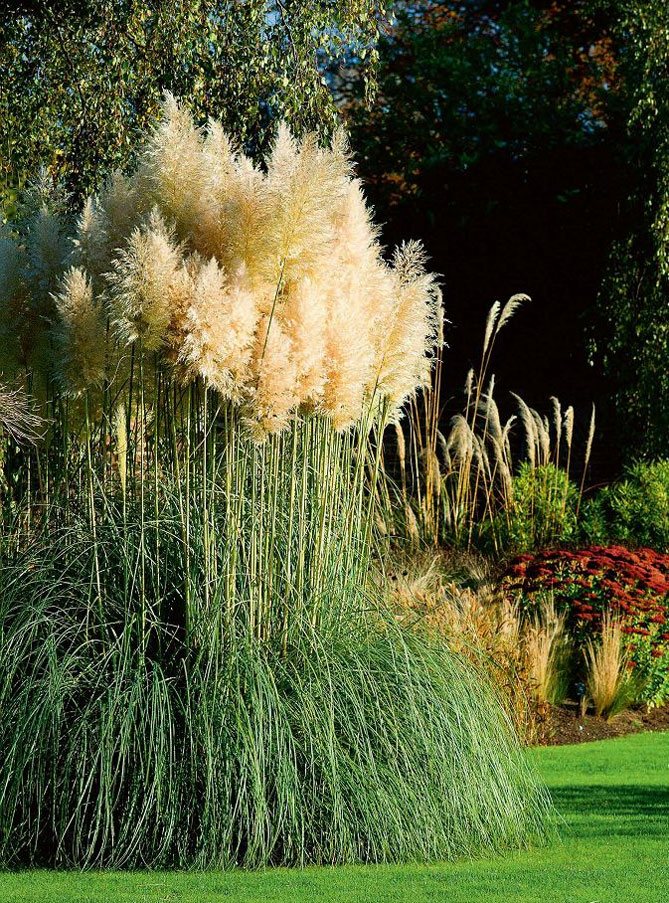

Cortaderia belongs to dioecious plants - male and female flowers appear on different plants.
The leaves of the cortaderia are long, reaching 1 meter. They lean towards the ground, forming picturesque dense clusters. A shrub 3-4 years old can have a height of 2 meters. There are also varieties of grass with striped leaves, such as cool ice.
During cultivation, the grass does not cause any problems, difficulties arise during the wintering period.
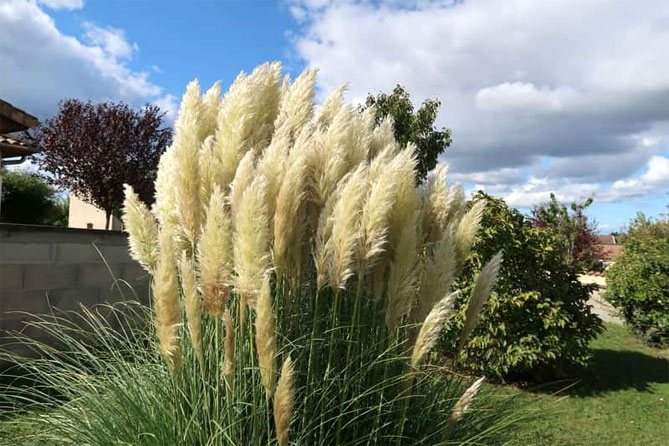

The pampas grass is the most beautiful of the herbs. Anyone can grow it in their garden!


The plant is large - it grows up to 2.5 meters. Garden decoration can be unusual. Learn how to grow it to grow strong and healthy.
Pampas grass (lat. Cortaderia) belongs to the tallest grasses (although there are also low varieties). Its unusually beautiful, silvery-gray, feathery panicles appear in September. They also look great in winter when they wither. The plant is native to South America, therefore it is not frost-resistant. The cortaderia must be covered for the winter.
Pampas grass seedlings can be purchased at garden shops, nurseries, and garden fairs. The largest selection is in spring and early summer. Small, young plants take root faster and better than older ones. Good quality seedlings should have intense leaf color and a dense root ball.
Varieties
Cortaderia has won a loyal following and is found in numerous varieties, differing in size, color, resistance to freezing temperatures. Due to the low frost resistance of the grass, many varieties are not suitable for wintering in the open field. It is necessary to choose varieties that are characterized by high frost resistance.
In our gardens, the most common type of Cortaderia selloana - the bush has green leaves, light inflorescences, grows up to 2-3 meters in height.
The following varieties are popular.
- The widespread variety "Remorino", the height of the shoots reaches 2.5 meters, the plants are resistant to our conditions. Remorino is a tall herb with long silvery buds.
- The varieties are characterized by silvery panicles 1 meter long:
- "Pumila" (pumila) - compact form, relatively low height - 1 meter, creamy white fluffy panicles, the most frost-resistant variety;


- "Elegans" (elegans);
- "Argentia" (argentea) - a silvery-white inflorescence.
- "Sunnigdale Silver" - large, silvery-white inflorescences, grows up to 2.5 meters.
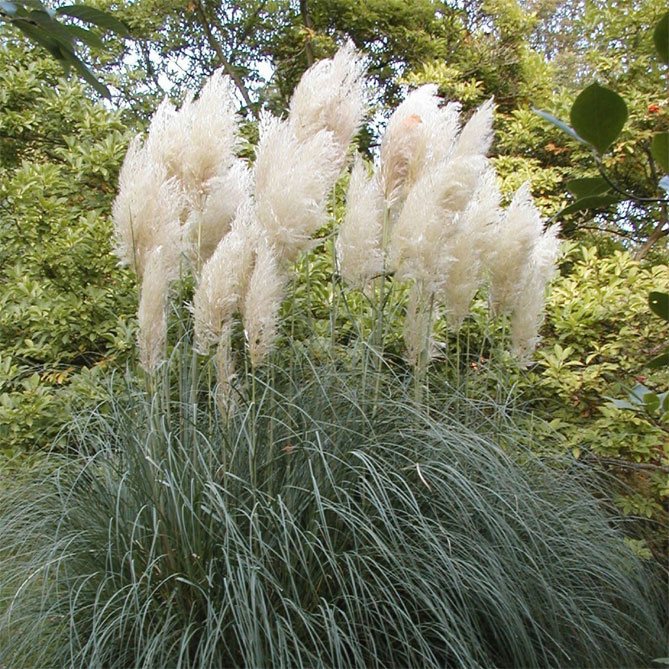

- Pink grass is very specific, popular varieties:
- "Rosea" (Rosea) - creates impressive panicles of silver-pink color, blooms in late September, grows up to 2 meters;


- "Pink Feza" (Pink feather);
- "Rendatler" (Rendatleri) - with brownish-pink panicles, resembles wild grass, shoots 2 meters high.
- Cool ice is a variety with striking striped leaves.
- "Gigantea" (Gigantea) - the height in optimal conditions can exceed 3 meters.
- Andes Silver - creates tall, creamy panicles.
- "Silver Comet" (Silver Comet) - a very original variety with silvery striped, narrow leaves.


- Splend>
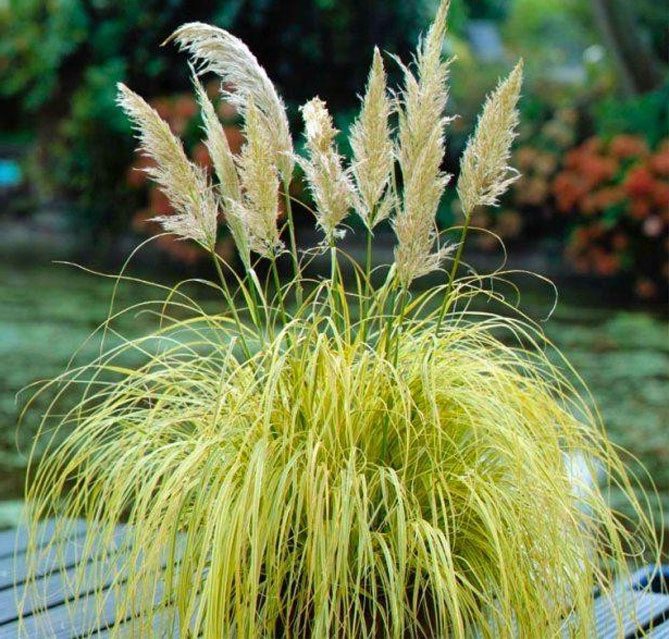

- "White" - a variety with white, beautifully presented flowers.
- Albolineata - leaves with white edges.
- "Aureolinata" (Aureolineata) - yellow edges of the leaves.
- "Evita" is a low grade, reaching a height of 75 cm.
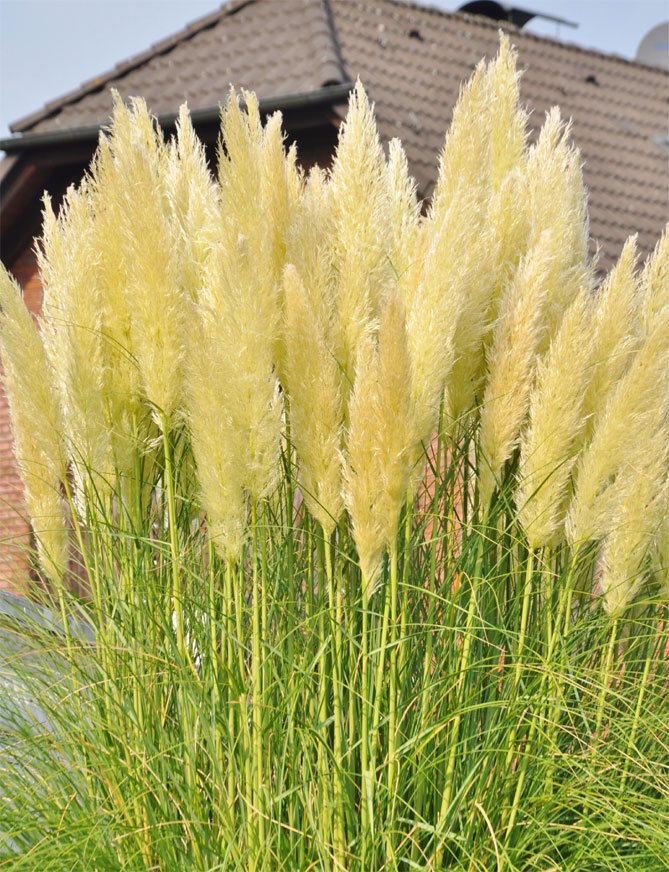

- "Patagonia" (Patagonia) - medium-sized variety, light green leaves, flower panicles of light or reddish color.
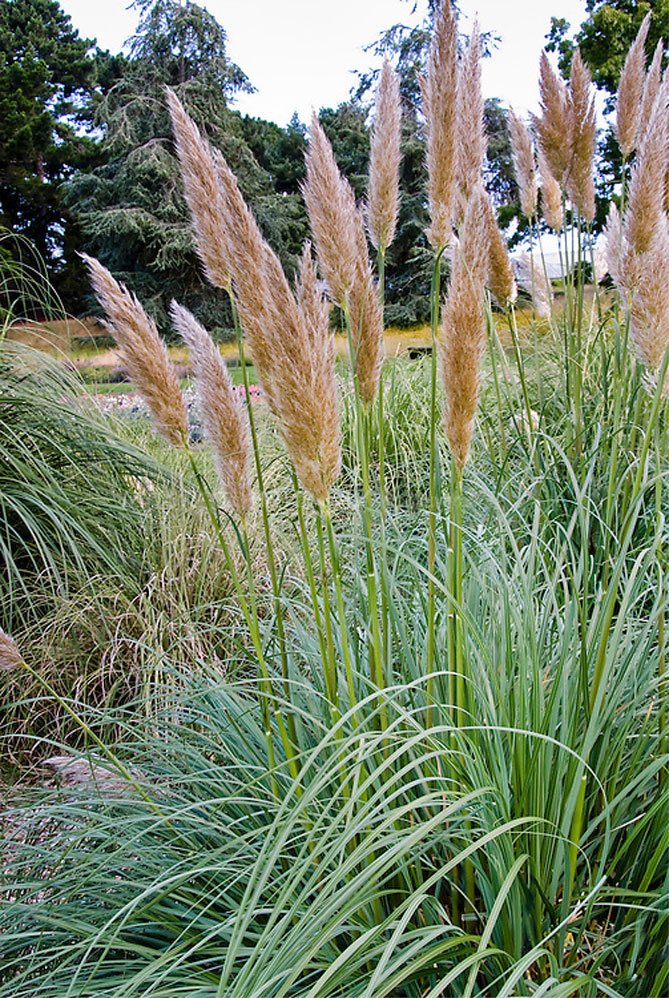

In warm countries, you can grow grass varieties with inflorescences in various interesting colors (pink, white). In our climate, these varieties do not have a chance to spend the winter, and if they succeed, flowering is rare.Therefore, it is worth choosing frost-resistant varieties.
The most frost-resistant variety in our climatic conditions is "Pumila" with cream-colored inflorescences.
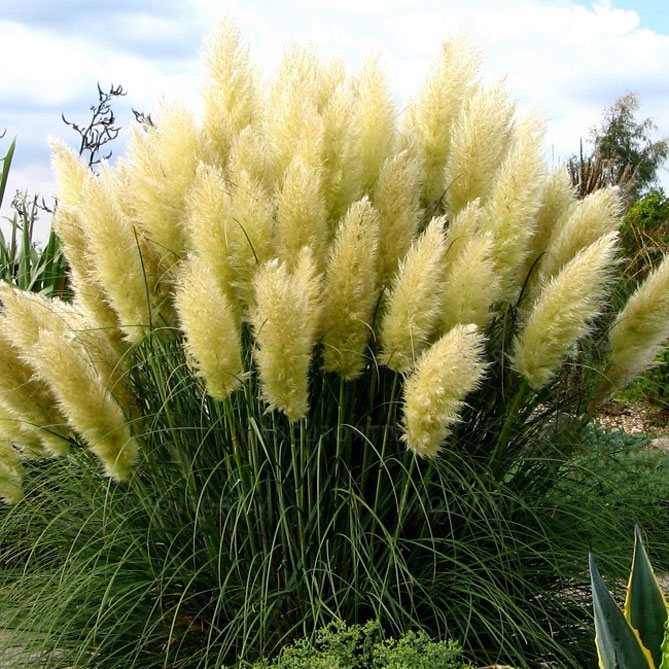

It is worth noting the frost-resistant undersized variety "Splendid Star", 1 meter high, with white striped leaves.
Description and varieties
Pampas grass forms dense and lush turf from tough, long and thin, curved leaves that form a green fountain shape. The edges of the plate are covered with sharp teeth that can damage the skin or cause irritation.
Cortaderia is a plant of beautiful late flowering, the decorativeness of which is fully revealed in autumn. In the middle of summer, peduncles begin to form from the center of the sod, similar to corn cobs in a shell.
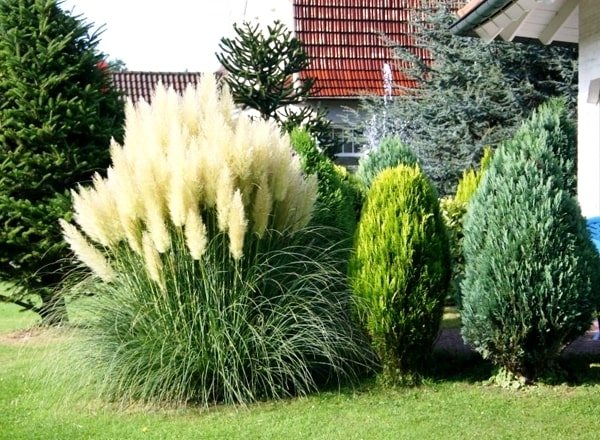

At the end of growth, stunningly beautiful, long, fluffy, paniculate inflorescences, similar to feathers, are formed on the tops. Depending on the variety, they can be silvery white, cream or pink.
It is difficult not to pay attention to such beauty, especially since the decorativeness of the majestic cereal retains for a very long time and over time can grow into dense plantations.
Cylindrical emperor "Red Baron"
Pampas grass is a dioecious plant that forms decorative panicles only on female plants. Male inflorescences are quite modest and small, so such specimens are not in wide demand.
In horticulture, high varieties of silver cortaderia with huge inflorescences are popular: Sunningdale Silver, Silver Comet, Silver Feather. From the pink cortaderia, a very effective variety "Rosea".
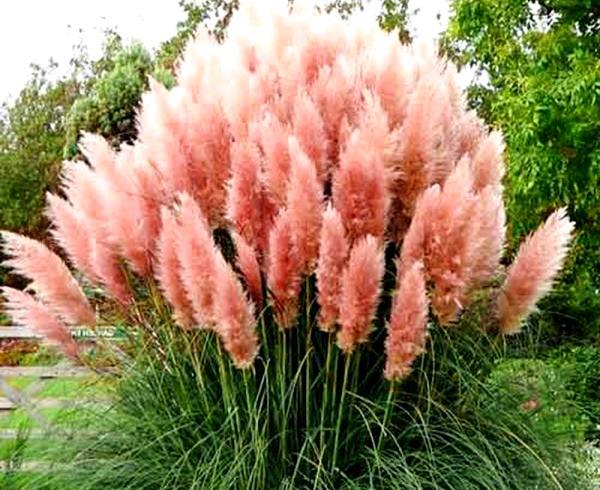

Pink cortaderia "Rosea"
Low varietal forms are more hardy. These include the "Pumila" variety, 1.5 meters high, with pink or silvery-white inflorescences.
Reproduction of cortaderia
Pampas grass propagates in the following ways:
- generatively - by seeds;
- vegetatively - by dividing the bush or cuttings.
Reproduction by division
Cortaderia is a dioecious plant. Women's flowers look the most impressive. Male inflorescences look much less impressive, as if they are wet, stuck together. Therefore, it is preferable to propagate the cortaderia by dividing the female plants. Then there is confidence that the resulting seedlings will repeat the characteristics of the mother plant.
The best time for dividing the bush is May-June, although some sources speak of early spring, before the beginning of the growing season. The rhizome is dug up and divided into several parts. By propagating a bush of grass that has already produced inflorescences, you can be sure that the separated plants will bloom as well. Plants with large root systems will grow better and bloom next year.
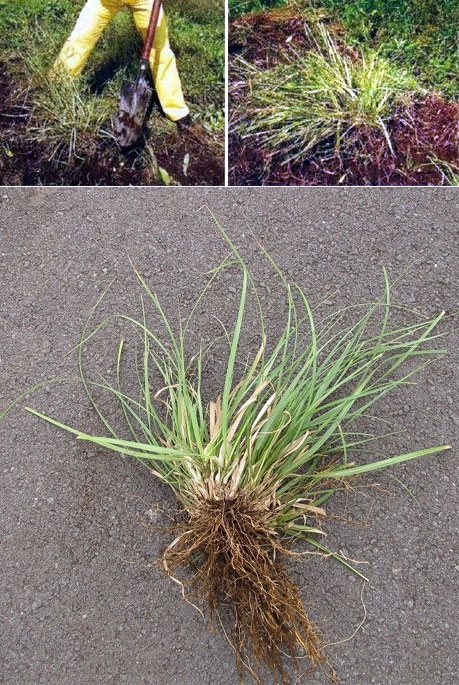

The grass is most often planted when the first true spring days (May) come, preferably a sunny day. In March-April, it is necessary to remove frozen, dead leaves after winter. The plant will quickly begin to release new shoots.
Propagation by cuttings
You can try growing grass from cuttings taken from old bushes in late summer. Cut off shoots several centimeters long. The lower part is dipped in a rooting machine and planted in the ground.
Seed planting
When growing pampas grass from seeds, you need to take into account:
- half of the seedlings will produce less showy male flowers;
- seedlings obtained from seeds will not always bloom;
- flowering usually occurs after 3-4 years.
In our climate, the plant does not set seeds, so it is impossible to collect them on your own.
Seeds of pampas grass are sown early, you can start sowing from February (preferably in March) in boxes. Since the seeds are very small, it is worth mixing them with sand and then covering with sand. Young plants germinate in 2-3 weeks at room temperature (20-22 ºC).
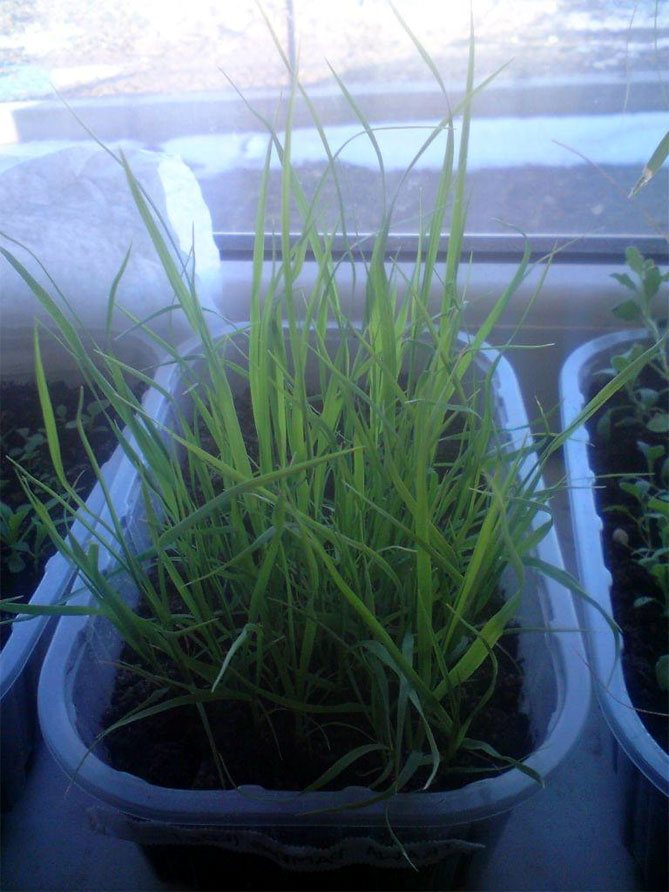

Such seedlings subsequently require picking into large containers with a diameter of 8-10 cm.For the summer they are placed outside. Saplings grow very quickly, but in the first year it is better for them to spend the winter in an unheated, but well-insulated greenhouse.
Growing cortaderia from seeds at home
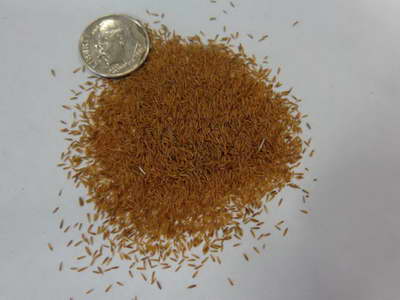

Pampas grass cortaderia seeds as they look like in a photo
When seed propagation of cortaderia, seedlings should be grown. Sow pampas grass in March-April. It is advisable to pre-stratify the seeds (keep them in the vegetable section of the refrigerator for about 1 month). For sowing, you will need flat containers and a sand and peat mixture. Fill containers with soil, level. You can plant several seeds in peat tablets.
- The seeds are very small - they should be spread less often over the surface of the soil with only light pressure, moistened with a fine spray.
- Germinate at room temperature, the room should be well ventilated. Provide diffused lighting.
Grass cortaderia planting seeds photo seedlings
- After 10-14 days, sprouts will appear.
- Water in moderation.
- Grow the grown plants very carefully in separate pots and grow in bright, diffused lighting, providing moderate watering and room temperature.
- A couple of weeks before transplanting into open ground, start hardening the seedlings: take them outside in the daytime for several hours, gradually increase this time, bringing them to a day.
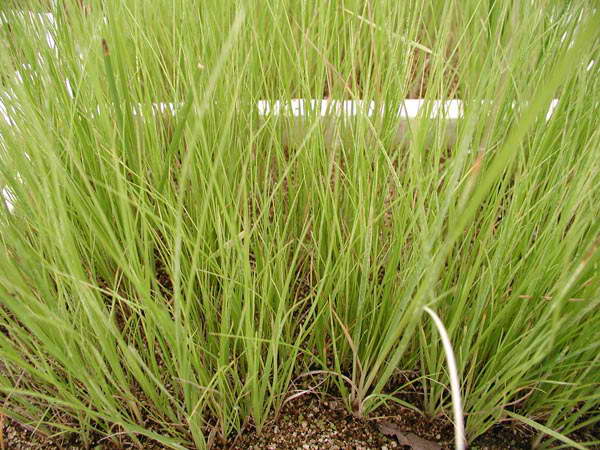

Grass cortaderia planting seeds photo seedlings
- Planting in open ground with the establishment of real heat.
- With seed reproduction, flowering occurs in the 5th year of growth.
Landing
Young plants are best planted in a permeable substrate; a humus mixture of peat and sand is optimal.
Landing requirements
Pampas ornamental grass likes places that are fully sunlit, sheltered from the wind, and its long leaves are quite fragile. The planting site can be chosen surrounded by tall conifers or under a wall with a southwest or south exposure.
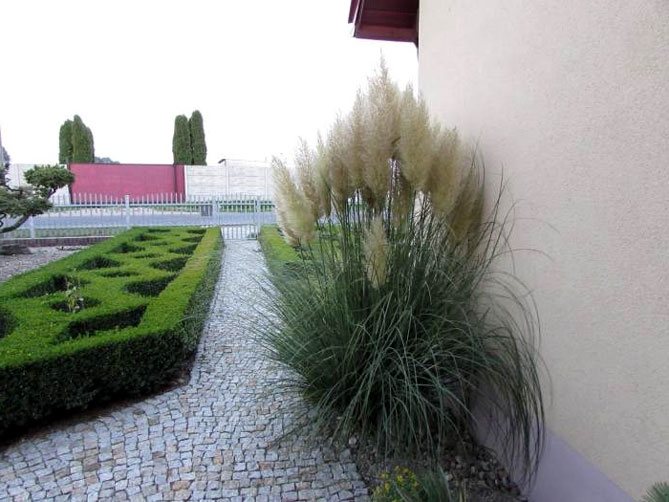

You can not plant grass in pits, depressions of the soil, where water stagnates!
The most suitable time for planting is late spring, because the plant requires warmth to grow, in addition, in the initial period, the bush is especially sensitive to cold. Therefore, planting is usually carried out in May, after the last frost.
Attention! The temperature for growing cortaderia should not fall below -17 ° C.
Preparing the soil for planting
A permeable, fertile soil similar to pampas is required. If you plant the grass in the shade, it will most likely not bloom. On heavy clay soil, the cortaderia quickly disappears. The soil should be moderately moist, rich in calcium. Under no circumstances should the soil be too wet. Excess water causes the grass to rot and die. For this reason, grass is not planted near water, for example, near a pond at the bottom of a slope. The top layer of soil is mixed with coarse sand and gravel, and a lot of compost is added to the deeper layer.
The way the soil is prepared differs depending on the soil conditions in the garden.
How to plant grass in permeable and sandy soils
Growing grass on permeable and sandy soils, dig a hole to the permeable soil layer and fill it with a mixture composed in the following proportions:
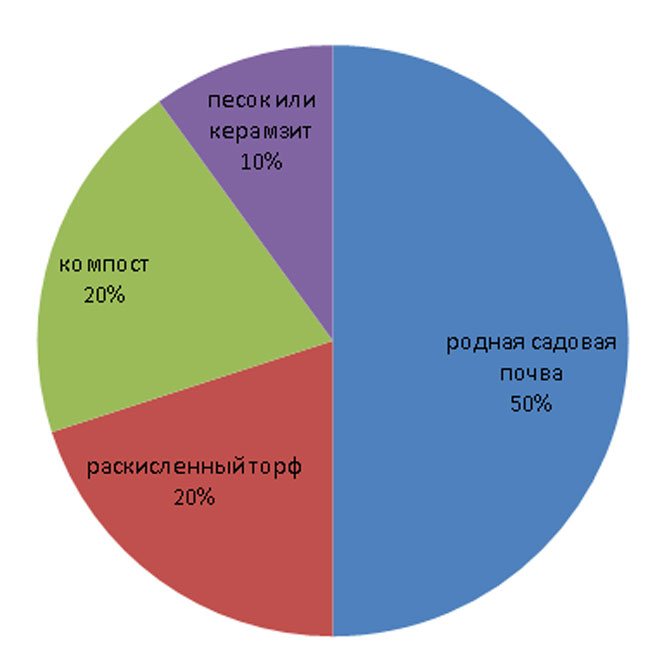

The prepared soil is filled with a hole and a small embankment is created, which will divert excess water to the sides during snowmelt or heavy rains.
Planting on heavy clay soils
If the grass will be planted on soils with impermeable layers, clayey (a symptom is a longer stagnation of water, for example, after rainstorms), drainage must be performed at the bottom of the pit. The thickness of the drainage layer is at least 20 cm, the composition is coarse gravel or small pebbles. Drainage in the case of heavy and clayey soils is necessary to remove excess water, which exposes plant roots to rot. The soil is compiled without using native soil, if clay prevails in it.Instead, you can increase the proportions of peat, compost and sand. In this case, the mixture should contain about 30% sand.


Growing
Pampas grass, as befits a queen, is demanding. It is important to know how to properly grow and care for a plant. Growing requires many procedures, the bush loves the sun and well-permeable soil, and long preparations are required for wintering.
The grass is negatively affected by:
- cold winds
- excess moisture
- severe frost.
Therefore, growing grass requires many protective measures.
Attention! The edge of the leaf blade is covered with tiny, sharp teeth - it is easy to cut the skin with the leaves. Thick gloves are required for work.
Watering
The cortaderia grass needs regular watering during the growing season. It is especially important to remember about irrigation during a drought. You need to water the plant, trying not to wet the leaves with water. It is necessary to ensure that there is no stagnation of water from watering, this leads to inhibition of flowering and even to the death of the plant. For these reasons, growing grass is quite difficult.
In rainy weather, in the cold season, it is advisable to equip a waterproof roof so that the soil under the plant dries out.
Fertilizer
It is important to systematically feed the cortaderia with nutrients rich in nitrogen, which will accelerate growth and flowering.
Organic fertilizers are best suited - compost, which is spread out in a thin layer every year before the beginning of the growing season. It is advisable to regularly feed the plant before flowering, but it is important not to overdo it because over-fertilization interferes with normal growth.
Usually the grass is fed twice:
- the first feeding - in May;
- the second in July.
Complex fertilizer must be dissolved in water and watering the seedlings. In the spring, you can feed the grass with Azofoska every 3-4 weeks.
Wintering
Cortaderia in our climate often freezes, especially young seedlings. Overwintering pampas grass requires special protective measures. The best way is to tie the top shoots into a sheaf. It is best to hold the event when the grass starts to turn yellow. It is advisable to pre-cut the grass to a height of 30-40 cm. Sheaves of bound grass of bizarre shapes will give a charming look to the winter garden. The grass will then be safe and very decorative. She can scare off four-legged intruders who gnaw on the bark of trees in winter.


In order for the water to flow down the top of the sheaves, you need to tie all the leaves of the grass. It is also worth tying the bundles in several places, forming a tent-shaped bundle. You can throw a jute bag without a bottom over the plant, which is additionally filled with leaves. The leaves are harvested in the fall, dried in a dry, well-ventilated place so that they do not rot or rot. It is important that the leaves are dry and light when covered. Around the plant within a radius of 1 meter, the soil should be covered with a layer of dry leaves with a layer of up to 40 cm, sprinkling them with earth. In the spring, the leaves are removed. This is the best way to keep your grass overwintered.
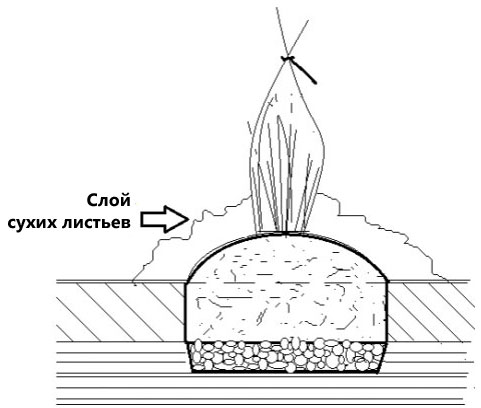

To prevent water from getting into the mulch, it should be covered with foil.


In cold regions, for example, in the Moscow region, it is recommended to cover the plant additionally with straw or agrotextile and even make a roof over the bush. In this state, the grass hibernates without watering.
In regions such as Siberia, the Urals, the cultivation of cortaderia is very burdensome. Since, in addition to protection from frost, the grass loves long daylight hours.
The grass can be transplanted into a pot and moved to a safe place for the winter. For this it is worth choosing the undersized variety "Pumila" (Pumila). In winter, the plant is stored in bright rooms with temperatures up to 10 degrees Celsius. In early spring, the bush is taken out to the balcony, terrace, cutting off last year's leaves, inflorescences. The same is done with the cortaderia planted in the garden. However, the grass does not tolerate such an annual excavation, its root system is easily damaged.Therefore, the more recommended wintering method is planting in a large pot, which is easy to carry and store in a cool and bright room during the winter.
Diseases and pests
Uncut, old grass can become a habitat for insects (even wasps). In general, the plant practically does not get sick. The main thing is to avoid excess moisture, which causes damping and rot.
Application in landscape design
The beauty of the flowers and leaves makes the grass look better like a tapeworm (planted alone), but it can be arranged in a naturalistic composition with other perennials, and even in the form of a hedge.
The grass looks very attractive in compositions with plants that change the color of the foliage in the fall. It is worth planting her in the company:
In the autumn key, the cortaderia plays great with the following ornamental plants:
The cortaderia is beautifully presented against the backdrop of dark hedges, over the pond and wherever garden architecture allows you to relax and unwind among the delicate rustle of grass.
Testimonials
When I first saw the Pampas grass in Yalta, I really wanted to plant it, but I was afraid to grow it in the ground. I planted it in a large pot of 12 liters. For the winter I transfer it to the veranda, where the average temperature is about 5 degrees. It grows well, blooms in summer, does not get sick. I really like!
I sowed the seeds in March, the seedlings were thin, I thought they would not survive, I did not dive, then I transplanted them into a pot and the pampaska started growing. Now the beautiful one is standing. In our climate, it can only be grown in pots, before the frosts I put it in the basement, I have it big and put it by the window.
In the suburbs, my cortaderia did not winter - it froze. Despite the fact that I covered her with leaves. She is afraid of both frost and damping, a dry winter is needed! You need to tie it into sheaves, make a roof on top. Maybe I chose the wrong variety, I don't remember the name anymore.
Pampas grass or Cortaderia sello (Cortaderia selloana or Cortaderia dioica) belongs to the bluegrass family and is a perennial ornamental plant with numerous thin leaves and fluffy inflorescences.
The pampas grass got its official name in 1818. It was first described by the German geographer botanist Alexander von Humboldt. This ornamental plant, cultivated in Western Europe and North America, got its name in honor of the traveler and naturalist Friedrich Sello.
Botanical description of pampas grass
- Height: up to 1-3 m;
- Stem: straight;
- Leaves: evergreen, thin, rough, numerous, therefore the plant resembles a feather. The length of the leaves is 1-2 m, the width is 1 cm. The color of the leaves: from bluish-green to silvery-gray;
- Flowers: collected in lush panicle inflorescences. The color can be golden, pink or silver. They are up to 90 cm long, so they rise high above the grass itself, creating a decorative look;
- Bloom: from August to November.
The basis of the name Cortaderia is the Spanish word "cortar" which means "to cut", apparently as a reminder of the sharp edges of the leaves of this plant.
Pampas grass leaves
In nature, it grows in the pampas of South America and is a weed. Why? The point is that pampas grass has excellent adaptability:
- one pampas grass plant produces about a million seeds during its life;
- Cortaderia can grow in a wide range of natural environmental conditions and is therefore considered a biodiversity-threatening weed in some places;
- when burning the roots of pampas grass, the roots always remain unharmed, it can only be dealt with using chemical reagents.
Description
Most often, one species is grown - Cortaderia selloana and its many varieties. The plant comes from the South of America, from the American steppes - Pump. At home, it reaches a height of 2-3 m, being one of the tallest grasses. The main object of admiration is the inflorescences.Especially female (dioecious plant) - they are more compact, well-built. Male inflorescences are looser, variegated. Inflorescences appear in late summer and autumn.
Leaves are gray-green, 1-2 cm wide, tough, but so long they form a fountain 1-2 m high. They are sharp at the edges and can scratch your skin if they come into contact with them.
For good growth, pampas grass requires adequate space.
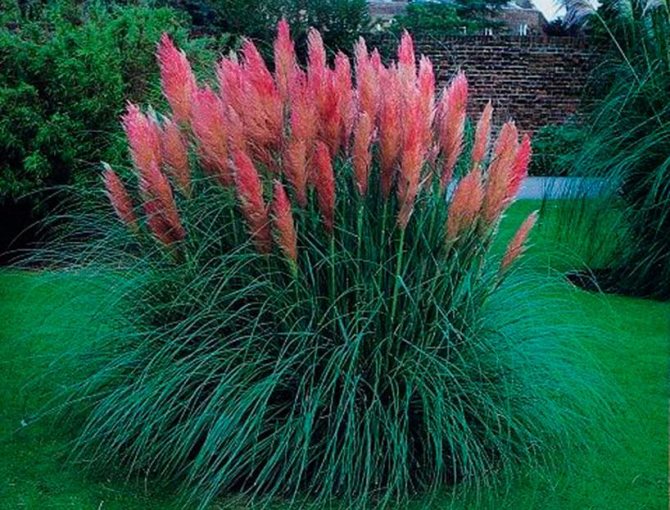

The landing site should be selected taking into account the following factors:
3:137
- a lot of sunlight;
- fertile soil;
- high soil moisture in summer;
- good soil permeability.
Unacceptable for her:
3:388
- lowering the soil;
- elevations of the ground - hills, slopes.
The grass looks very good by the garden pond.
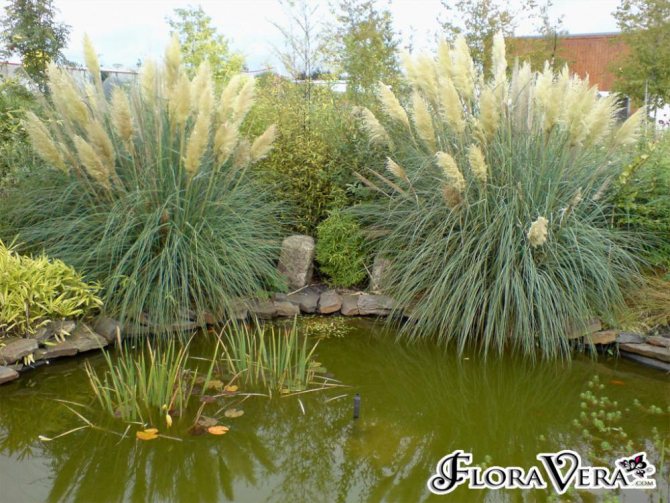

Growing pampas grass
Cortaderia can be grown from seed and by dividing the bush.
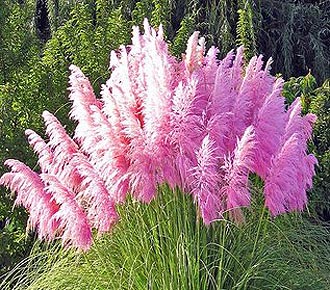

Growing from seeds
Seeds are usually sown in spring. But it is possible in the fall, only in warm regions, or if containers with it remain in a warm room. In the middle lane, seedlings sown in autumn may not survive the winter outdoors.
Another option for planting in the fall is to plant seeds directly into the ground, where they will stratify over the winter, and seedlings may appear in the spring. But it is better not to risk it and grow seedlings in the spring, at home.
Sowing includes the following steps:
- Seeds are stratified: placed in a refrigerator in late winter-early spring so that the protective shell collapses;
- Sow on well-moistened soil (universal soil) in April-May;
- Sprinkle with earth on top (3-4 mm);
- Sprayed with a spray bottle;
- Placed in a warm, ventilated place;
- After two weeks, sprouts appear;
- When warmth comes, they are transplanted into the ground or, together with the container, are taken out into the garden.
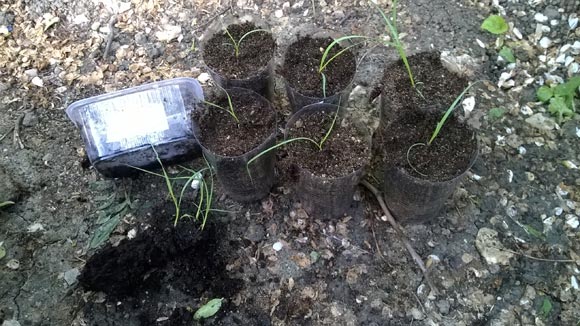

The advantage of this kind of cultivation is getting grass with a certain color of inflorescences (pink, silver, golden). The downside is that flowering will have to wait five years.
Therefore, if you want to immediately get beautiful inflorescences, it is better to use the division of the bush.
Reproduction by dividing the bush
The division of the bush is carried out in late winter or early spring. The grass prefers fertile, drained soil. It is necessary:
- Dig a small hole (up to 40 cm in depth and width) at the end of spring, if there are several plants, then the distance between them should be at least 1.5 m;
- Make drainage. To do this, you need to pour pebbles, gravel, etc. on the bottom;
- Add peat, compost or manure;
- Gently spread the roots of the plant and plant in the hole;
- Sprinkle with earth on top and pour over.
Pampas grass prefers sunny open places. It is unpretentious in maintenance and has high survivability.
Cortaderia is not picky about the soil and can grow in drought, swampy conditions, and even on stony ground. But in such conditions, it loses its decorative properties and may even stop blooming.
Therefore, to create decorativeness, you need:
- Watering in the first year once every two weeks, more often in drought. In subsequent years, you can water less often;
- Top-dressing once a year in spring with complex fertilizers;
- In November, you should tie the leaves of the plants with a rope so that all the water from them flows well, this will facilitate wintering. Or it is better to cut it by 30-40 cm;
- Cover the roots for the winter with straw or other mulch, and it is also advisable to cover it with a warm cloth or a heap of leaves in cold regions;
- Pruning is required in late winter or early spring;
- The grass is not affected by pests and diseases.


Planting and caring for cortaderia in the open field
Site preparation
Prepare the site in advance: dig up the soil, you can add rotted manure, compost or peat, remove weeds. Directly on the day of planting, dig the planting holes to the size of the root system. At the bottom, lay a drainage layer of coarse sand.
How to plant
- Transfer cortaderia seedlings along with an earthen clod.
- Sprinkle with earth, pour abundantly.
- The root collar should be slightly deepened (this applies to both seedlings and cuttings) to protect the bushes from freezing.
- Neighboring crops should be about 1.5 m from the bush.
Watering
Cortaderia is drought tolerant, but ensure regular watering for proper development. During a prolonged drought, apply about 20 liters of water under each bush at intervals of 3-4 days.
Top dressing and pruning
- It is enough to feed once a season: apply complex mineral fertilizers in the spring.
- Pruning is an important part of plant care. Cut off dead leaves annually in the spring, thin out the center of the bush, remove last year's panicles.


